Qualcomm Intros Snapdragon X Plus, Details Complete Snapdragon X Launch Day Chip Stack
by Ryan Smith on April 24, 2024 9:15 AM ESTSnapdragon X Plus: Second Verse, A Bit Less Than the First
Alongside today’s announcement of the Snapdragon X chip SKUs and the Snapdragon X Plus branding, Qualcomm put together a short presentation on the Snapdragon X Plus. Given that the underlying hardware is identical to the Snapdragon X Elite, there’s not much to talk about here in terms of technology or technical specs.
But ahead of the mid-year hardware launch, Qualcomm is providing some fresh performance slides, comparing the Snapdragon X Plus to its current-generation competition from Intel and AMD, as well as Qualcomm’s own Snapdragon X Elite. As with all vendor-provided benchmarks, these should be taken with a grain of salt. But if nothing else, it’s notable here what Qualcomm is and isn’t saying.
With 10 high-IPC CPU cores, Qualcomm should fare well in multi-threaded workloads, and this is exactly what they’re opting to promote. According to the company, the Snapdragon X Plus has a significant edge in both performance and power consumption at iso-power and iso-performance respectively. In the case of Cinebench 2024MT, that’s a 28% performance advantage over the Core Ultra 7 155H, or matching that chip’s peak performance at 39% lower power consumption.
Notably, however, what you won’t find from Qualcomm is any material promoting Snapdragon X Plus’s single-threaded performance versus any competition. With those peak clockspeeds of 3.4GHz, the Plus isn’t in a very favorable position versus the 4.8GHz Core Ultra 7 155H, even with what is presumably an IPC advantage.
As far as Qualcomm’s own chips are concerned, the Elite understandably has the advantage at any point on the curve in these MT tests. For a given architecture, a larger number of CPU cores is always the more energy efficient options, never mind the Elite’s clockspeed advantage on top of that. In any case, Qualcomm’s own figures put the Plus at about 15% behind the flagship Elite in Geekbench, and around 20% behind in Cinebench.
The company is also touting an advantage in GPU performance. Though as the benchmark in question is 3DMark Wildlife Extreme, a bencehmark that Qualcomm has already optimized for forwards, backwards, and upside-down within their drivers, I’m more interested in seeing how more PC-exclusive workloads perform. Though to Qualcomm’s credit, they’re no stranger to that space either, as they’ve been shipping Windows-on-Arm Snapdragon SoCs for several years now.
Snapdragon X Plus: Live and In Person
Finally, alongside briefing the press on the Snapdragon X Plus, Qualcomm also had some devices using the new chip SKU to show off, demonstrating the performance of the chip. This setup was similar to Qualcomm’s Snapdragon Summit preview event for the Snapdragon X Elite in October, albeit a bit more free-wheeling and hands-on now that the hardware is a bit more mature and there’s less of a chance of something going awry.
As with that preview event, Qualcomm has equipped their own internal reference design laptops with the chips. With its lower performance, all of the Snapdragon X Plus systems were the “config B” system, which is Qualcomm’s thin-and-light reference design, sporting a 14.5-inch OLED screen and designed for a total system TDP of 23 Watts.
| Qualcomm Snapdragon X Reference Test Systems (Thin and Light) | ||
| AnandTech | Snapdragon X Elite (X1E-80-100) |
Snapdragon X Plus (X1P-65-100) |
| 2 Core Max Turbo | 4.0GHz | 3.4GHz |
| All Core Max Turbo | 12C @ 3.4GHz | 10C @ 3.4GHz |
| GPU | 3.8 TFLOPS | 3.8 TFLOPS |
| RAM | LPDDR5X-8448 | LPDDR5X-8448 |
| Display | 14.5-inch OLED 2880x1800 |
14.5-inch OLED 2880x1800 |
| Thickness | 15mm | 15mm |
| Device TDP | 23W | 23W |
| Cooling | Active | Active |
| Battery | 58Wh | 58Wh |
The Elite version of this laptop was running the X1E-80-100 chip (the same chip as last time) which features a reduced performance GPU, a peak dual-core CPU clockspeed of 4.0GHz, and an all-core turbo of 3.4GHz. Meanwhile the Plus system has an identical GPU and all-core turbo clockspeed, but only 10 CPU cores with a peak dual-core CPU clockspeed of 3.4GHz.
As before, these systems were pre-configured with major benchmarks selected by Qualcomm, including Geekbench 6.2, Cinebench 2024, UL Proycon, PCMark 10, 3DMark, Blender, and new-to-Windows-on-Arm, Chrome. Qualcomm did let us touch these machines this time around, but these demos are still primarily being hosted to prove that Qualcomm is achieving the performance figures they claim.
On that note, here’s a quick rundown of Qualcomm’s performance claims, and what we observed for the Plus in action.
| Qualcomm Snapdragon X Benchmark Scores (Thin and Light) | ||||
| AnandTech | Elite - QC Expected Range | Plus - Observed | Plus - QC Expected Range | Plus vs Elite Performance |
| Cinebench 2024 ST | 121-123 | 109 | 107-109 | 89% |
| Cinebench 2024 MT | 920-980 | 860 | 825-845 | 86% |
| Geekbench 6.2 ST | 2750-2800 | 2420 | 2400-2425 | 87% |
| Geekbench 6.2 MT | 14200-14400 | 13049 | 12800-13100 | 91% |
| Chrome - Speedometer 2.1 | 450-470 | 426 | 410-430 | 91% |
| Chrome - JetStream 2.1 | 310-320 | N/A | 280-290 | 91% |
| PCMark 10 Applications | 12800-13200 | N/A | 12500-12800 | 97% |
| UL Procyon - Office Productivity | 6200-6500 | N/A | 5700-5900 | 91% |
| UL Procyon - AI CV Inference | 1750-1800 | N/A | 1750-1800 | 100% |
| 3DMark Wildlife Extreme | 37.1-38.5 fps | 37.1 | 37.1-38.5 fps | 100% |
| Blender (CPU) | 380-410 | N/A | 340-360 | 88% |
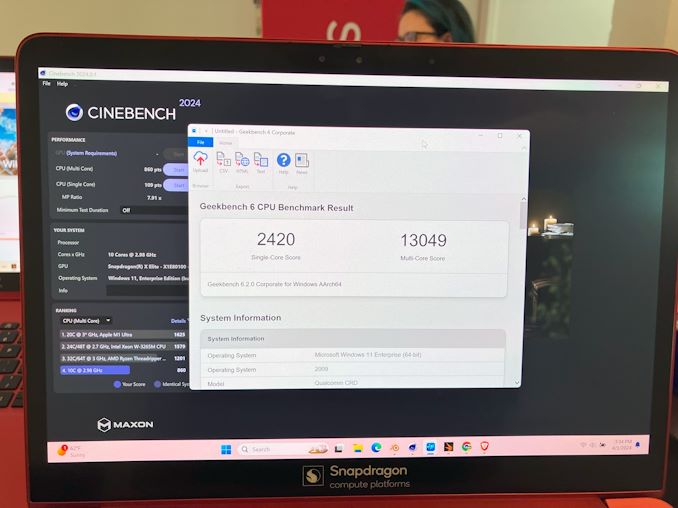
Geekbench 6.2 & Cinebench 2024
And with a little hands-on time, I even convinced Qualcomm’s representative to run the newer Speedometer 3.0 test on Chrome, which has just come out and was not yet part of their official benchmark suite. It scored 22.8.
Notably, here, the Snapdragon X Plus is closer in performance than what clockspeeds alone would predict. In Qualcomm’s supplied benchmark results, the Plus is never more than 14% behind in multithreaded workloads, and 13% behind in single-threaded workloads. And most of the time, it’s a 10% difference or less.
The 23 Watt system-wide TDP limit of the Qualcomm reference system is relatively constraining, all things considered. So I would not be the least bit surprised if the Snapdragon X Elite is being held back, in part, by not being able to run faster within Qualcomm’s systems. In other words, this is a more real-world test, as opposed to testing peak-to-peak unbounded by TDP concerns.
Overall, I don’t know if anything presented with the Snapdragon X Plus thus far would be considered all that surprising. With Qualcomm making their biggest push into the PC market yet, it makes perfect sense that they’re introducing multiple SKUs – and that they’d need some kind of branding to differentiate them. And while the Plus obviously won’t deliver the kind of chart-topping highs that the Elite will, it’s still based on all the same hardware that Qualcomm is banking on to make their reset PC ambitions a success. So like the rest of the Snapdragon X family, I’m looking forward to seeing what the hardware – Oryon CPU cores and all – can deliver when it launches in the middle of this year.


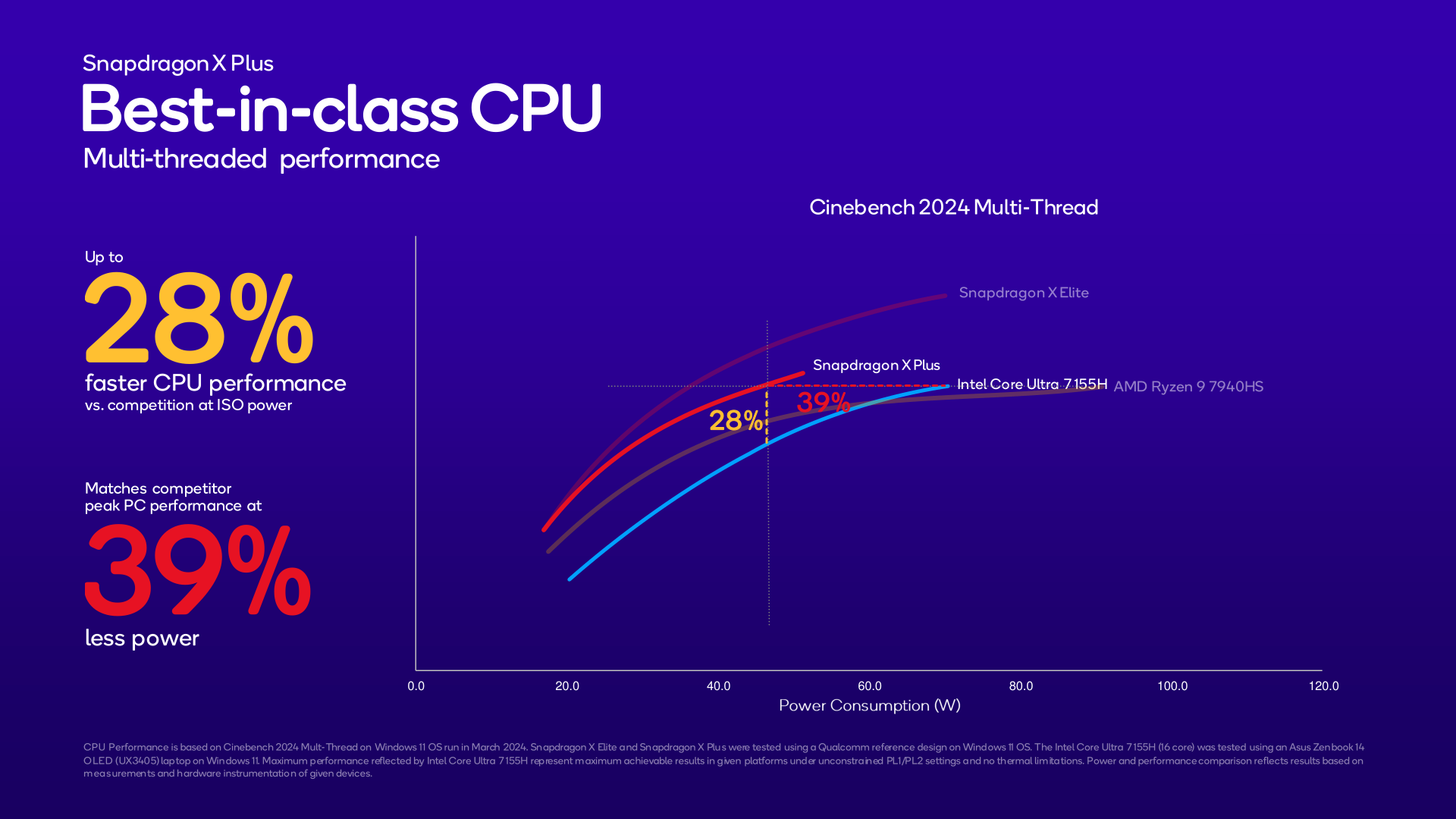
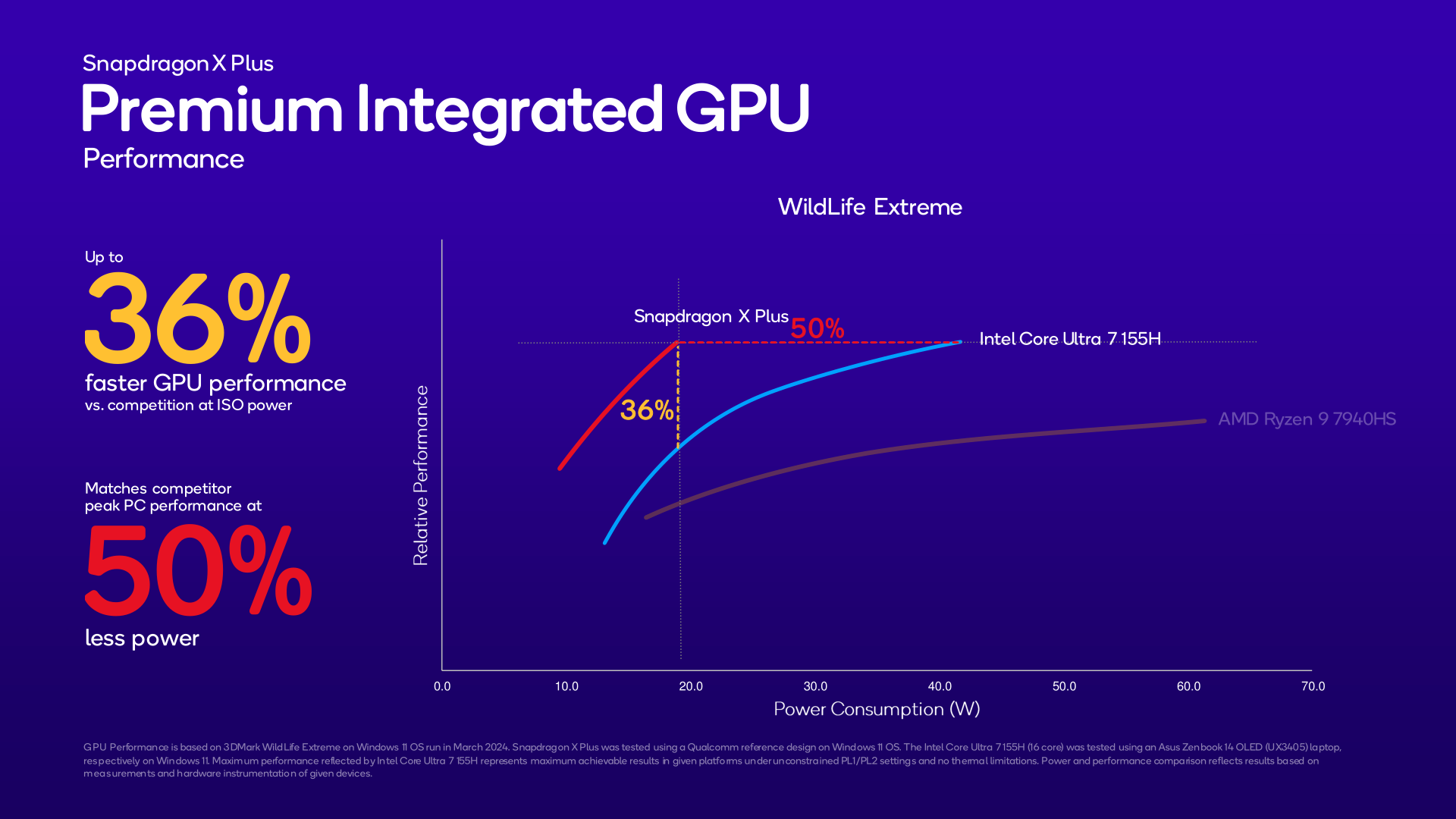







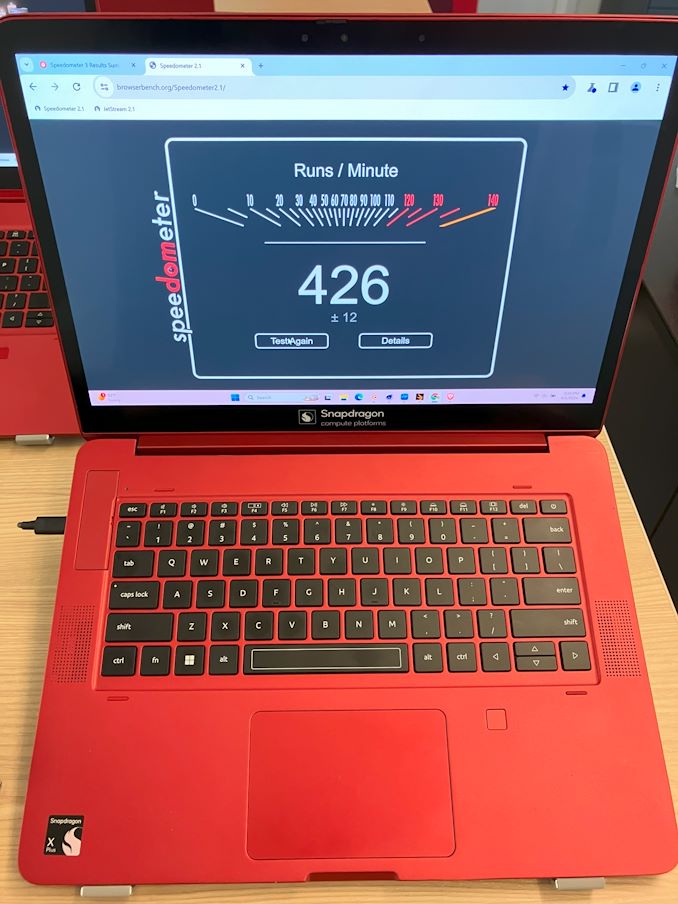

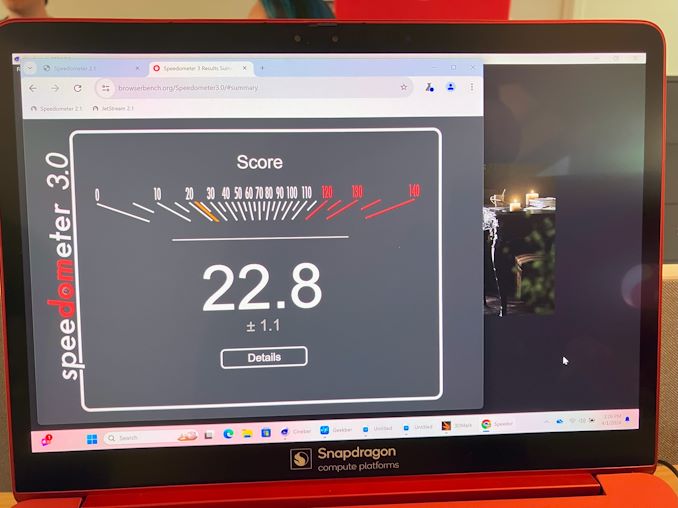









50 Comments
View All Comments
Eliadbu - Wednesday, April 24, 2024 - link
Looks like typical scumbag Qualcomm we love to hate. If it's the truth, other than it will be a flop, every competent true reviewer and not some shill influencer, will rip this product apart. What were they thinking? That they could get away with this? That people will forget their promises? That they make will make those bogus number a reality when it comes out? This is just sad, although I hate Qualcomm as a company, I see them as necessary evil to push efficency on windows machines, now all they do is drive me further into buying apple's Mac with their overpriced memory and storage configs. Replymeacupla - Wednesday, April 24, 2024 - link
You should take the numbers given by Qualcomm with a grain of salt, but you should also be weary of semiaccurate's recent reports.50%, if true, would not only be a total failure, it would be a litigation nightmare. Like way beyond the scope of number fudging that is legally allowed by the feds. Reply
Hifihedgehog - Thursday, April 25, 2024 - link
Andrei now does performance analysis for NUVIA. He needs no introduction and his work speaks for itself. I trust the numbers since the conditions are very transparently listed in the bottom notes including OS, memory speed, total platform/device power and so on. In fact, that 23 watt limit for QC’s thin and light reference device is impressive when you realize that also is the maximum power envelope for the display, memory and NVMe under full load.SemiAccurate cannot give specifics because there are none. I wouldn’t be surprised if Intel is trying to submarine Snapdragon X’s release and Charlie took the bait. His site became trash over the last 3-5 years and this is the tip of the iceberg of the drivel is shovels out these days. He couldn’t even get his web forum with years of subscriber content and discussion back online that his $1.5K/year subscribers wanted—so much for Charlie being tech savvy. Ignore that idiot and his keyboard warrior mind-numbing rants. Reply
haplo602 - Thursday, April 25, 2024 - link
Hmm ... well given the TDP numbers from the Qualcomm graph, I'd be suspicious a lot. How can the Ryzen 7940HS reach almost 100W when the official TDP is 35-54W ? Yes I know the PPT is higher but not 100W high, I think the maximum official PPT is 65W. Comparatively the Intel 155H can boost up to 115W yet the benchmark cuts of below 80W ?So did they measure power at the wall ? Then I wonder why since that is not comparable across devices and has no meaning what so ever when comparing CPUs ... I just don't buy the graphs when there is so much information missing. Reply
meacupla - Thursday, April 25, 2024 - link
There are a few mini-PCs that allow you to manually set the power limits of a 7840HS/7940HS.The total power tends to top out at 90W, with around 40W going to the GPU. Reply
eastcoast_pete - Thursday, April 25, 2024 - link
While I value and respect Andrei's expertise and really miss his analysis here, he is now an employee of Qualcomm; and being an employee means that you have to tow the company line, only speak out publicly if authorized to do so, or you get fired and then sued for damages to boot! Employment contracts are full of clauses that are there to prevent any employee from speaking out of turn, especially if you work in R&D. That is not just so at Qualcomm, but is true at pretty much any larger corporation, at least in the US. Replyeastcoast_pete - Thursday, April 25, 2024 - link
Didn't see your post, I just put that also in my post here. Definitely something worth reading, and for Qualcomm to respond to! ReplyTerry_Craig - Wednesday, April 24, 2024 - link
I don't believe the supposed launch is just this pathetic copy and paste of suspicious numbers provided by Qualcomm. How horrible... they didn't send any laptops for review? Replykn00tcn - Wednesday, April 24, 2024 - link
nowhere did anyone state this is a launch,it's a product brief about a couple months before launchthe very first sentence even says "preparing for mid-year" Reply
Terry_Craig - Wednesday, April 24, 2024 - link
This is a big circus tent set up by Qualcomm clowns. Reply